Monuments Depicting Victims of the Dakota Uprising
The following photos and information are about monuments that have been built to honor those who suffered during the Dakota conflict. For photo credits, please see the Monuments Slide Show Tab.
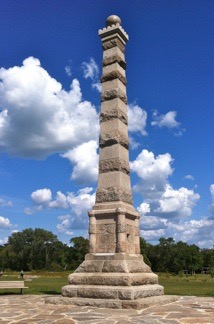
Fort Ridgely State Monument

This monument is located at Ft. Ridgely State Park located on County Road 30 near Fairfax. The inscription reads: "In memory of the fallen, in recognition of the living and for the emulation of future generations." Part of the inscription states "Erected A. D. 1896, by the State of Minnesota to preserve the site of Ft. Ridgely, a United States military post established in 1853, and especially to perpetuate the names and commemorate the heroism of the soldiers and citizens of the State, who successfully defended the fort during nine days of seige and investment, August 18-27, 1862, and who gallantly resisted two formidable and protracted assaults upon it, made August 20 and 22, 1862, by a vastly superior force of Sioux Indians under command of Little Crow and other noted Indian leaders and warriors.”
The inscription reads: “Fort Ridgely, Minnesota's third military post, was established in 1853 to defend the frontier and watch over the Sioux who had been moved to the Minnesota Valley two years earlier. When it was completed in 1855, the fort consisted of a large parade ground surrounded by stone and wood buildings. From 1853-1862 the post was garrisoned first by regular U.S. army troops and then, after the outbreak of the Civil War, by volunteer regiments. When the Sioux Uprising began in 1862, Fort Ridgely assumed great importance as the only military post in the valley and a vital defense point against the Indians. Hundreds of settlers flocked here for safety only to encounter two Sioux offensives; these attacks were repelled mainly by the skillful use of artillery by the fort's defenders. After the withdrawal of the military in 1872, most of the buildings deteriorated or were converted to others uses by settlers. In 1896 the state of Minnesota erected a monument commemorating the battles fought near the old parade ground. In 1911 the legislature created Fort Ridgely Memorial State Park. Archaeological excavations in 1933 uncovered the foundations of eight building sites, all now marked. The commissary, the only stone building from the old fort to be preserved, has been restored for use as a visitor's center. Created by the Minnesota Historical Society 1971.”
Fort Ridgely is a state historic site now managed by the Nicollet County Historical Society. The fort was a training ground for Civil War recruits and now features reconstructed fort foundations. The commissary building, which was restored by the CCC, is now its Interpretive Center and contains exhibits about life around the garrison during the 1850s and 60s. The website is: www.mnhs.org/fortridgely
Fort Ridgely Cemetery
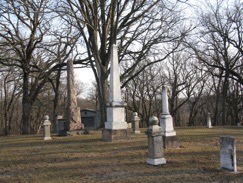
The cemetery is adjacent to the Fort Ridgely State Park located along State Highway 4, six miles south of Fairfax. It is the final resting place of two heroes of different interests of the Dakota War: Captain John Marsh, a soldier; and Eliza Muller, a nurse. Chief Mou-zoo-mau-nee, a Chippewa Indian, is not buried here but a marker is here to honor him. The photo depicts these three tall tombstones, left to right, Chief Mou-zoo-mau-nee, John Marsh and Eliza Muller. See their individual monuments below for more detail.
Lake Shetek State Monument

This monument memorializes the 15 people who died in the attack on Lake Shetek on August 20, 1862. The names of the slain were: Almira Hatch Everett, John Voigt, Willie Everett, 5 years, Andrew Kock, Charlie Everett, 2 years, John Eastlick, 29 years, Sophia Walters Ireland, Frederick Eastlick, 4 years, Sarah Jane Ireland, 5 years, Giles Eastlick, 2 years, Julianne Ireland, 3 years, Wm. J. Duley, Jr., 10 years, Sophia Smith, Belle Duley, 6 years. The monument was established by the State of Minnesota in 1925 and is located near Currie in Murray County.

The inscription reads: "At this site lie the bodies of fifteen people in a mass grave ten feet long, four feet wide and four feet deep. Contained in this grave are the remains of six adults and nine children killed either at Lake Shetek or at Slaughter Slough on August 20, 1862.” The fifteenth victim, whose name does not appear on the monument, was a twelve year-old boy killed in the late afternoon of the 20th. Mistakenly identified as Frank Eastlick, he lies with the rest, his name unknown to this day. Originally, the bodies of the slain lay unburied from August 20, to October 16, 1862. The bones were collected and buried by the edge of Slaughter Slough in a shallow grave and lay there until the following year. On October 31, 1863, a military burial party, commanded by Captain Starkey and assisted by Wm. Duley, Captain of Scouts, with the aid of Thomas Ireland, Charles Hatch and H. Watson Smith reburied the remains at this present location. The State of Minnesota began construction of this monument in 1924. It was completed and dedicated to the memory of those who were slain in the Lake Shetek Indian Massacre of Aug. 20,1862 and to commemorate the privations and hardships and the heroic deeds of the surviving pioneer settlers of Murray County and Vicinity. in 1925.

Camp Release State Monument
The site is significant because it is the first state park in Minnesota and the spot where about 2000 Dakota Indians were taken into custody. The monument was erected in 1894 to commemorate the release of 269 hostages taken captive, 107 whites and 162 mixed bloods. It is also the site where the trials were held for many Dakota and a jail was built to house them during the trials. The four faces are inscribed with information about the battles during the conflict, the surrender and information about the monument. The monument is 50 feet tall and located near Montevideo, just off Hwy. 212.
Wood Lake State Monument
 This monument commemorates those who died in the Battle of Wood Lake, the last decisive battle of the Sioux Uprising (US/ Dakota Conflict) of 1862. Colonel Henry Sibley defeated the forces of Chief Little Crow on September 23, 1862. This ended the outbreak in Minnesota.
This monument commemorates those who died in the Battle of Wood Lake, the last decisive battle of the Sioux Uprising (US/ Dakota Conflict) of 1862. Colonel Henry Sibley defeated the forces of Chief Little Crow on September 23, 1862. This ended the outbreak in Minnesota.
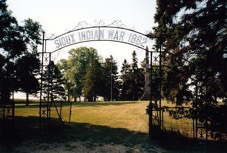
On the left is the entrance to the battlefield named Wood Lake. This site is located off of Minnesota 67 on Yellow Medicine CR 18. To read further about the misnomer of the name, go the Wood Lake Battlefield Preservation Association website at www.woodlakebattlefield.com
(Tom Hosier, the Wood Lake Battlefield Preservation Association President, recently announced that the conservation easement on the 240 acre Coulter farm has been completed. On December 14, 2011, all documents were signed, money paid, and necessary registration was filed in Yellow Medicine County. This land contains the major part of where the Wood Lake Battle was fought. The work by the WLBPA, Civil War Trust and SHPO (State Historic Preservation Office) has taken almost 6 years to complete. Now the WLBPA board can begin the work of planning how to have public interpretation of the site with the help from an American Battlefield Protection Program grant.)
Birch Coulee State Monument
This monument was erected by the State of Minnesota in 1894 and is located on  the east side of Morton, high on the bluff which overlooks the Minnesota River Valley. The monument is a 52-foot granite shaft that honors the memory of those soldiers who were wounded or died in the Battle of Birch Coulee. The battle took place September 2 and 3, 1862, and and the fighting continued both days, but was much more intense at the beginning. Joseph R. Brown's burying party were camped at this spot, located about 17 miles from Fort Ridgely. The early morning assault led by Mah-Ka-to left 23 who died, 13 at the battle site, and about 50 wounded, while the Dakota suffered but two casualties. The next afternoon, or 36 hours after the siege began, help arrived. The detachment was relieved by Col. Sibley's soldiers from Fort Ridgely. For more details on this battle, see Curtis Dahlin's account in "The Dakota Uprising, A Pictorial History," pgs. 88-93. The book, "The History of Renville County, Vol. 2,” beginning on p. 1342, gives much detail of the building of this and other Renville County monuments. You can find this e-book by googling the above title and typing Monuments in the search box.
the east side of Morton, high on the bluff which overlooks the Minnesota River Valley. The monument is a 52-foot granite shaft that honors the memory of those soldiers who were wounded or died in the Battle of Birch Coulee. The battle took place September 2 and 3, 1862, and and the fighting continued both days, but was much more intense at the beginning. Joseph R. Brown's burying party were camped at this spot, located about 17 miles from Fort Ridgely. The early morning assault led by Mah-Ka-to left 23 who died, 13 at the battle site, and about 50 wounded, while the Dakota suffered but two casualties. The next afternoon, or 36 hours after the siege began, help arrived. The detachment was relieved by Col. Sibley's soldiers from Fort Ridgely. For more details on this battle, see Curtis Dahlin's account in "The Dakota Uprising, A Pictorial History," pgs. 88-93. The book, "The History of Renville County, Vol. 2,” beginning on p. 1342, gives much detail of the building of this and other Renville County monuments. You can find this e-book by googling the above title and typing Monuments in the search box.
Birch Coulee Battleground


These four photos were taken at the State Historic Site located three miles north of Morton, at the junction of Renville County Hwys. 2 and 18, one mile east of U.S. Highway 71. The site features a self-guided tour of the battleground focusing on the perspectives of Joseph Anderson, a captain in the U.S. Army, and Wamditanka (Big Eagle), a Mdewakanton soldier. The Battle of Birch Coulee was one of the hardest fought battles of the Dakota War as the U.S. soldiers were kept under siege for 36 hours before help arrived from Fort Ridgely. The National Park Service has provided a link to this battle and other events of the war at: http://www.nps.gov/history/history/online_books/soldier/sitec6.htm



Marker located at the Birch Coulee Battleground
Inscription: “600 feet south in the ravine the Whites were attacked by the Sioux Indians under Mah-Ka-To Sept. 2, 1862.”
Monument to the Loyal Sioux Indians
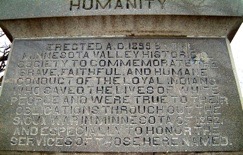

In 1899, the Minnesota Valley Historical Society erected an approximately 50-foot high monument strictly to honor those faithful Indians who were loyal to the whites during the uprising. The stipulations were that they must be full-blooded Indian, they were to have been loyal throughout the entire outbreak, and that they were responsible for saving the life of at least one white person. There were only six Dakota who qualified but there were many others, including mixed-bloods, who helped out with escape plans, warning the settlers and special acts of kindness showed to some prisoners at Camp Release. This monuent is located on the east side of Morton, high on the bluff which overlooks the Minnesota River Valley.

The words ‘Patriotism, Courage, Fidelity, and Humanity’ are on the four sides of the monument and on the ‘Humanity’ side, the inscription reads: “Erected A. D. 1899 by the Minnesota Valley Historical Society to commemorate the brave, faithful, and humane conduct of the loyal Indians who saved the lives of white people and were true to their obligations throughout the Sioux War in Minnesota of 1862 and especially to honor the services of those here named: Other Day – Ampatutokicha; Paul – Mahzakutemanne; Lorenzo Lawrence – Towanetaton; Simon – Anahwangmanne; Mary Crooks – Mahkahta Heiya win; Maggie Brass – Snana win”
New Sweden Monument

This memorial is located on the south side of Highway #22 in Norseland, Minnesota. The inscription reads: “Mrs. Maria Jonsson, wife of Erik Jonsson, and their son Pehr, were killed by Sioux Indians on August 23, 1862, near their home in New Sweden Township, about five miles northwest of this marker. Both natives of Sweden. Mrs. Jonsson was thirty-five and Pehr was twelve years old at the time of the massacre. Another son, August, born in New Sweden Township in 1861, died of exposure two days after his mother's death. All three bodies are buried in this cemetery which was consecrated in 1859 by the Scandian Grove Lutheran Church. The Jonsson homestead was one of the eastern-most sites involved in depredations committed by the Indians during the Sioux Uprising in 1862. "Days of affliction come to meet me" Job 30:27. This marker was erected in 1962 by the Scandian Grove Lutheran Church in grateful memory of those pioneer members of the congregation.”
The Acton State Monument
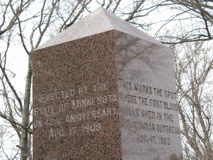
 This monument is located south of Grove City in Acton Township, Meeker County. It is the site of the Howard Baker cabin and was the initial incident of the Dakota War. No bodies are interred here but are buried in a single grave in the Ness Cemetery located five miles east of this monument. See the Acton Incident Marker and the Ness Lutheran Church State Monument for more details.
This monument is located south of Grove City in Acton Township, Meeker County. It is the site of the Howard Baker cabin and was the initial incident of the Dakota War. No bodies are interred here but are buried in a single grave in the Ness Cemetery located five miles east of this monument. See the Acton Incident Marker and the Ness Lutheran Church State Monument for more details.
Here are the inscriptions found on the the four sides of the monument:
“Victims - Robinson Jones Ann Baker-Jones Howard Baker Viranus Webster Clara D. Wilson. This marks the spot where the first blood was shed in the Sioux Indian outbreak, Aug. 17, 1862. Bodies of these victims are buried in Ness Cemetery. Erected by the State of Minnesota on 47th anniversary, Aug. 17, 1909.”
Leavenworth Rescue Expedition Monument
The inscription reads: “During the Minnesota Sioux Uprising of 1862, eighteen men left New Ulm early on the morning of August 19, and travelled westward about 20 miles along the Big Cottonwood River to the area of Leavenworth. Searching for relatives and friends, they found dead settlers and wounded children. Two men took the wounded by wagon to New Ulm, and during the day another man left and two more joined the group. Part of the expedition returned to New Ulm about 3:00 P.M., during the first attack on the town. They descended the hill near the present Loretto Hospital and crossed the slough below where five were killed by Indian ambush. One half hour later the other men returned and were also surprised here and six killed. Unknown to the expedition some of their families and neighbors had reached safety within the New Ulm barricades.

Casualties Survivors
3:00 P.M. 3:00 P.M.
William B. Carroll Philip Kirby
Thomas Riant Luther C. Ives
Almond D. Loomis Robert A. Henton
George Lamb Charles Koehne
Jan Thomas Samuel McAuliffe
3:30 P.M. 3:30 P.M.
William Tuttle Ralph Thomas
Uriah Loomis
DeWitt Lemon
Ole and Nels Olson
Tore Olson”
A book entitled The Leavenworth Rescue Expedition Revisited, by Gary Wiltscheck, adds detail to the events, places, and people connected to this Leavenworth marker, shown above. More information on Books page. This monument is located at 5th Street and Garden, in New Ulm.

Defenders State Monument
The Defenders Monument, located on Center Street in New Ulm, commemorates the two battles fought there in 1862. Noted artist Anton Gag created the artwork at its base. An inscription reads, “The monument was erected by the State of Minnesota to commemorate the battles and incidents of the Sioux Indian War of 1862, which particularly relates to the town of New Ulm — 1890. Honored be the memory of the citizens of Blue Earth, Nicollet, LeSueur and adjacent counties, who so gallantly came to the rescue of their neighbors of Brown County and by their prompt action and bravery aided the inhabitants in defeating the enemy in the two battles of New Ulm, whereby the depredations of the savages were confined to the border, which would otherwise have extended to the heart of the State.” The monument looks to be made of stone but it is actually metal. The Brown County Historical Society has a Virtual Tour of their historic places. This site shows photos depicting the two battles and a accompanying detailed description of those battles. Go to: http://www.newulmtel.net/~dfilzen/page17.html
 Closeup of the Anton Gag relief at the foot of the monument on the left.
Closeup of the Anton Gag relief at the foot of the monument on the left.
Pioneer Monument

The Pioneer Monument is located in New Ulm in front of the Brown County Courthouse. It not only honors Minnesota Territorial and Brown County pioneers but also lists the 113 citizens from Brown County who lost their lives during the Dakota War. The monument was dedicated during Minnesota's Territorial Centennial on October 7, 1949, commemorating the day the first white settlers arrived in New Ulm. No one is interred here. Many bodies of the settlers were never recovered, so the memorial is their only remembrance. Those that were recovered are probably buried in either the New Ulm City Cemetery or the New Ulm Catholic Cemeteries. Here is the inscription from the other view: "To pay homage to the sturdy pioneers who founded the territory of Minnesota a century ago. And to express veneration for the pioneers of Brown County and members of their families who lost their lives during the Sioux War of 1862-1863. This memorial is reverently dedicated by the Brown County Historical Society this 7th day of October, in Minnesotas Territorial Centennial, A.D., 1949. On this day in October 1854, the first white settlers arrived in New Ulm. May the present generation and those to come consider the debt they owe to those worthy pioneers and emulate their fortitude in preserving democratic principles in this nation.” INSCRIPTION: "MEN, WOMEN AND CHILDREN WHO LOST THEIR LIVES IN THE SIOUX WAR OF 1862-63 IN THE PRESENT AREA OF BROWN COUNTY."For additional photos and the list of 113 names, see this website: http://www.newulmtel.net/~dfilzen/page27.html
 Ness Lutheran Church State Monument
Ness Lutheran Church State Monument
This monument, located in the Ness Lutheran Cemetery near Acton in Meeker County, marks the common grave of the first white settlers killed in the Dakota Uprising on August 17, 1862. It was dedicated in 1878 and is one of Minnesota's oldest monuments. Robinson and Ann Jones, Howard Baker, Viranus Webster and Clara Wilson were the victims killed that day. It all began with the discovery of chicken eggs by four Dakota hunters and ended with a target shooting contest. After round one, the Dakota reloaded their guns but the innocent whites did not. The four Dakota began their day hunting and ended their day convincing their leaders to go to war.
Milford State Monument
 This is the Milford Monument, located two and a half miles northeast of Essig and 8 miles west of New Ulm on County Road 29 in Brown County. The monument, erected in 1929, gives the names of the 52 settlers who were killed in Milford Township. Their names were: John Martin Fink, Monika Fink, Max Fink, Carl Merkle, Florian Hartmann, John Baptist Zettel, Barbara Zettel, Elizabeth Zettel, Stephan Zettel, Anton Zettel, Johanna Zettel, Max Zeller, Lucretia Zeller, John Zeller, Monica Zeller, Cecilla Zeller, Conrad Zeller, Martin Zeller, Anton Messmer, Mary Ann Messmer, Joseph Messmer, Martin Henle, Anton Henle, Mary Henle, Frank Massopust, Mary Ann Massopust, Mary Massopust, Julia Massopust, Frank Massopust, John Rohner, Barbara Rohner and one child, Sebastian May, Barbara May, Henry May, Bertha May, Henry Heyers, Dorothea Heyers, Joachim Heyers, Mrs. Joseph Stocker, Benedict Drexler, Frank Drexler, Christ Haag, Adolph Schilling, John Kech, Mrs. Brigitta Pelzl, Fred Gluth, Joseph Emmerich, George Roesser, Barbara Roesser, Theresia Eggensdoerfer.
This is the Milford Monument, located two and a half miles northeast of Essig and 8 miles west of New Ulm on County Road 29 in Brown County. The monument, erected in 1929, gives the names of the 52 settlers who were killed in Milford Township. Their names were: John Martin Fink, Monika Fink, Max Fink, Carl Merkle, Florian Hartmann, John Baptist Zettel, Barbara Zettel, Elizabeth Zettel, Stephan Zettel, Anton Zettel, Johanna Zettel, Max Zeller, Lucretia Zeller, John Zeller, Monica Zeller, Cecilla Zeller, Conrad Zeller, Martin Zeller, Anton Messmer, Mary Ann Messmer, Joseph Messmer, Martin Henle, Anton Henle, Mary Henle, Frank Massopust, Mary Ann Massopust, Mary Massopust, Julia Massopust, Frank Massopust, John Rohner, Barbara Rohner and one child, Sebastian May, Barbara May, Henry May, Bertha May, Henry Heyers, Dorothea Heyers, Joachim Heyers, Mrs. Joseph Stocker, Benedict Drexler, Frank Drexler, Christ Haag, Adolph Schilling, John Kech, Mrs. Brigitta Pelzl, Fred Gluth, Joseph Emmerich, George Roesser, Barbara Roesser, Theresia Eggensdoerfer.
Henderson Monument and Plaque

This monument honors Mrs. S.R. (Clarissa) Henderson, and her two daughters (one named Lydia), and Jehiel Wedge, Eugene White and F. Thies. It was erected in 1907 by Renville County Pioneers in memory of five victims who were killed in the Dakota War of 1862 and F. Thies who died years later. It was originally located 1 1/2 miles southwest of its current site, on the Henry Homeier farm in Beaver Falls township where they were killed and buried. It was moved to its present location in 1981 by the Renville County Historical Society to the Morton Pioneer Monuments Roadside Parking Area. The marker is located north of the midpoint of the curved wayside rest area on the western side of Hwy. 71 about 1.4 miles north of County Rd 2. The site is located about four miles north of the town of Morton. Inscription on Henderson Monument: "Erected by Renville County Pioneers August 18, 1907. In memory of Mrs. S. R. Henderson and her two little daughters, Jehiel Wedge and Eugene White who were killed by the Indians in the massacre of August 18, 1862. F. Thies axcidently [sic] killed March 1873.” Text on Henderson Monument plaque: "This monument was originally erected 1 1/4 miles S.W. of this site. It was erected herein 1981. Renville County Historical Society.”

Signboard at the Morton Monuments site.
Redwood Ferry

“On a summer day in 1862 the Redwood Ferry landing on the Minnesota River below this point was the scene of the first attack against military troops in one of America's most tragic Indians wars. Early in the morning of August 18, 1862, a large part of Dakota (Sioux) warriors enraged by delayed annuity payments and near-starvation conditions on their reservation, attacked the nearby Lower Sioux Agency. Surviving agency employees crossed the river on the Redwood ferry and fled to Fort Ridgely some 13 miles downstream. Discounting warnings of the Indian's strength and determination, the fort's commandant, John S. Marsh, set out toward the agency with interpreter Peter Quinn and 46 soldiers of the Fifth Minnesota Infantry. They found the Dakota waiting in ambush at the ferry. In the ensuing fight, Quinn and 23 soldiers were killed and Marsh was drowned while trying to escape by swimming across the river. The remaining men eventually made their way back to Fort Ridgely which was itself attacked on August 20 and 22. The war in the Minnesota River Valley claimed the lives of at least 450 whites and an unknown number of Dakota before it came to an end at Camp Release on September 26, 1862.”
This marker is located between Morton and Franklin on Highway 19, overlooking the Minnesota River. For more on the elusive ferryman, click on the the below pdf file. Citation: Joseph Connors, "The Elusive Hero of Redwood Ferry," Minnesota History 34 (Summer 1955): 233-38. The Elusive Hero of the Redwood Ferry.pdf

Jackson State Monument
This monument is located in Ashley Park, Jackson County, off U.S. Highway 71. It honors the pioneer settlers who were killed in 1857 and 1862, and was erected here in 1909; the deaths occurred some miles to the north in 1862. Here is the transcription as found on findagrave: http://www.findagrave.com/cgi-bin/fg.cgi?page=cr&CRid=2340687. “Erected by the State of Minnesota in the year 1909, to the memory of the pioneer settlers of Jackson County, whose names are inscribed below, massacred by the Sioux Indians in 1857 and 1862. 28 March 1857 massacre: William Wood, Joshua Stewart, George Wood, Willie Thomas, two children of Joshua Stewart 24 August 1862 massacre: Ole Olson Fohre/Fyre/Førde (father), Mikkel Olson Slaabakken, Johannes Knutson, Axe/Ekse, Knut Haldorson Ro Mestad and wife, Brita Andersdatter Røte Mestad, Anna Knutsdatter Bjørgo Langeland (mother), Aagaata Knutsdatter Langeland (child), Anna Knutsdatter Langeland (child), Nicolai Johan Knutson Langeland (child), Knut Knutson, Langeland (child), Lars Larson Rasdal Hjørnevik and wife, Lars Larson Furnes/Furness/Furrenæs. 24 August 1862 wounded children who survived: Ole Olson Fyre (Ole F. Forde), the older Olson brother, age 11, Anders Engebretson Slaabakken Olson, age 11, Julia Knutsdatter Langeland, age 3.” From the Jackson County Historical Society: Commemoration and Honoring Victims of 1862 and 1857 Dakota Uprising. Dedication of the 1909 memorial to the victims of these massacres in Jackson County. Dates: Aug 23-25, 2012. Website: http://www.rootsweb.ancestry.com/~mnjackso/
Acton Incident

The inscription reads: “On a bright Sunday afternoon. August 17, 1862, four young Sioux hunters, on a spur-of-the-moment dare, decided to prove their bravery by shooting Robinson Jones, the postmaster and storekeeper at Acton in western Meeker County. Stopping at his cabin they requested liquor and were refused. Then Jones, followed by the seemingly friendly indians, went to the neighboring Howard Baker cabin, which stood on this site. Here the whites and the Indians engaged in a target-shooting contest. Suddenly, the Indians turned on the settlers and without warning shot Baker, Viranus Webster, another settler and Mr. and Mrs. Jones. Mrs. Baker, Mrs, Webster, and several children escaped by hiding. Then the Indians rode off shooting Jone's adopted daughter, Clara D. Wilson, as they passed the Jones cabin. The Indians fled south to their village forty miles away on the Minnesota River. There they reported what they had done, and the Sioux chiefs decided to wage an all-out war against the whites, triggering the bloody Sioux Uprising of 1862. The bodies of the settlers were buried in a single grave in the Ness Lutheran Cemetery, near present-day Litchfield. In 1878 the state of Minnesota erected a granite monument there. This site, where the Baker’s cabin stood, was similarly marked in 1909.” Erected by the Minnesota Historical Society. This monument is located south of Grove City on County Road 4 in Acton Township, Meeker County. It was erected alongside the Acton State Monument. See the Acton State Monument and Ness Lutheran Church State Monument on this page for further details.

Isle of Refuge
This memorial marker is located on 180th Avenue/County Road 40 in Kandiyohi County near Willmar. It depicts where settlers took refuge during the Indian attacks in the area. Thirteen settlers and an undetermined number of Dakota were killed in Kandiyohi County. Inscription on marker: During the Dakota Conflict of 1862, there were no casualties among the Norway Lake community settlers, although several from the nearby West Lake community were killed. On August 20, survivors from West Lake and other settlers from the Norway Lake area sought refuge on an island in Norway Lake. A crude canoe was used to bring the women, children and meager supplies out to the island. The settlers spent several days there, until a rescue party escorted them to the Paynesville area. Afterwards, this area was closed to settlement until 1864. The Norway Lake island became known as the "Isle of Refuge."

Monson Lake Historical Marker
This is an accompanying plaque that relates to the Broberg-Lundborg memorials. It is located in the Monson Lake Memorial Park, 1690 - 15th St. N.W., Sunburg, Minnesota. Inscription: "Near this spot in Monson Lake Memorial Park thirteen settlers - - members of the Anders P. and Daniel P. Broberg and Andreas L. Lundborg families were killed during the Sioux Uprising on August 20, 1862. This marker was presented by the Swift County Historical Society to the Monson Lake Memorial Association at the Centennial observance on Sunday, August 19, 1962."
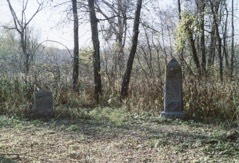
Redwood Ferry Markers
Located in a remote location inaccessible to the public on the north side of the Minnesota River near Morton, MN, these monuments honor the ferryman and the soldiers who fell during the ambush. For more on the elusive ferryman, click on the the below pdf file. Citation: Joseph Connors, "The Elusive Hero of Redwood Ferry," Minnesota History 34 (Summer 1955): 233-38. The Elusive Hero of the Redwood Ferry.pdf
Brave Settlers Monument
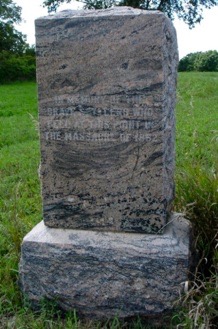
The monument is on County Road 21, section 35 of Flora Township, Renville County, in the Middle Creek settlement where several were killed by the Indians during the Sioux uprising of 1862. The monument's inscription reads: "IN MEMORY OF THE BRAVE SETTLERS WHO FELL AT THIS POINT IN THE MASSACRE OF 1862.” Thirty-nine settlers were killed at Middle Creek on Monday, August 18, and the killed and wounded are listed in Gregory Michno’s book, Dakota Dawn, p. 400: Gottlieb Boelter, Mrs. Gottlieb Boelter, John Boelter, Justine Boelter, three Boelter children, Gottfried Busse, Wilhelmina Busse, Augusta Bussse, Bertha Busse, Caroline Busse, John Frass, John Kochendorfer, Catherine Kochendorfer, Sarah Kochendorfer, John Lettou, Lettou child, Gottlieb Mannweiler, Annie Reyff, Benjamin Reyff, Eusebius Reyff Jr., Margreth Reyff, John Roessler, Mrs. John Roessler, Frederick Roessler, two Roessler sons, Louise Schmidt, William Schmidt, two Schmidt children, Johann Schwandt, Christian Schwandt, Christina Schwandt, Frederick Schwandt, Louis Seder, John Walz and Karolina Walz.
For biographies on the John and Justina Boelter family, see the memorial written by Bill Cox on findagrave: http://www.findagrave.com/cgi-bin/fg.cgi?page=gr&GSvcid=182561&GRid=60211782&
Chief Mou-zoo-mau-nee State Monument

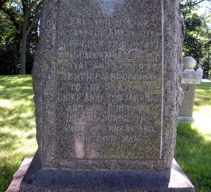
Chief Mou-zoo-mau-nee was a respected chief of the Mille Lacs Band of Ojibwe during the uprising and a "friendly" Indian to the settlers. He helped with the protection of those who sought refuge at Fort Ripley. The State of Minnesota dedicated this monument in 1914 which is located in the Fort Ridgely Cemetery. Chief Mou-zoo-mau-nee, a Chippewa Indian, is not buried here but a marker is here to honor him. Here is the inscription: "Erected by the State of Minnesota in recognition of and to commemorate the loyal and efficient services rendered to the state by Chief Mou-zoo-mau-nee and the Chippewa Indians during the Sioux outbreak and the Civil War." There were many "friendlies" and some were memorialized on the Loyal (Faithful) Indian Monument near Morton. But Taopi, or Wounded Man, Robert Hoskins Chaska, and Joseph (Akipa) Renville were three that bravely administered to the whites and did not receive such recognition. Curtis Dahlin's book, "The Dakota Uprising, A Pictorial History," gives more detail on these Dakota on pages 214-217. Upper right is that inscription on the Chief Mou-zoo-mau-nee Monument.

Civil War Recruiting Monument
Inscription: “While crossing this ravine a recruiting party of the Civil War was ambushed by the Sioux Indians on August 19, 1862, at the noon hour. The following were killed or mortally wounded: John Schneider, Ernest Dietrich, Julius Fenske, Adolph Steimle.” Several wagons, with brass band, left New Ulm on August 19th to recruit volunteers for the Civil War. The procession was ambushed at a bridge over a ravine west of town. The marker sits on the east side of the ravine, on the north side of county road 29, and is located about a mile east of the Milford Monument.

Manannah Massacre Monument
Inscription: “Manannah Massacre - Sioux Uprising - 600 Feet South - August 26 1862 - Philip H. Deck, Linus Howe, Joseph Howe, and Wilmot Maybee.” Eleven men who sought refuge at Forest City returned to their homesteads for provisions, and, on their return to Forest City, were ambushed on August 26, 1862. Four of the eleven men were killed. The monument sits on the south side of Meeker County Hwy 3, just west of the unincorporated town of Manannah. The victims are buried in Union Cemetery, about one half mile west of the monument.
Captain John S. Marsh State Monument

John Marsh was a Captain of the 5th Minnesota Infantry in August, 1862. On the morning of August 18, the settlers began arriving at the fort seeking refuge and sharing the news that a massacre had begun. His entire company was ordered to go to the Agency and found settlers fleeing, burning buildings, and many dead bodies. His company of 50 men were then ambushed at the Redwood Ferry located directly across the Minnesota River from the Lower Sioux Agency. Twenty-five men were killed including Captain Marsh who drowned while trying to swim across the river and ten were injured. His body was not found until four weeks after the attack. Captain Marsh and his men are immortalized in this Fort Ridgely Cemetery monument erected by the State of Minnesota in 1873. The inscription reads as follows: "In Memory of Capt. John Marsh, First Sergeant Russell H. Findley, Serg't Joseph S. Besse; Privates Charles R. Bell, Edwin F. Cole, Charles E. French, John Gardner, Jacob A. Gehring, John Holmes, Christian Joerger, Durs Kanzig, James H. Kerr, Wenzel Kusda, Henry McAllister, Wenzel Norton, Moses P. Parks, John W. Parks, John Parsley, Harrison Phillips, Nathaniel Pitcher, Henry A. Shepherd, Nathan Stewart, Charles W. Smith of Co. B, died Aug. 18, 1862. Fifth Regiment Minnesota Volunteer Infantry. Peter Quinn, U.S. Interpreter. Killed at Redwood Ferry, Aug 18, 1862."
Dr. John Wakefield’s House
Located at the Upper Sioux Agency (Yellow Medicine), the plaque was erected to show the location of the physician’s home during the time of the Dakota outbreak.

Inscription:
The Doctor's House
A one and one-half story farm
house, measuring 30' X 20' was
erected for use by the agency
physician, Dr. J.W. Daniels, and later
Dr. J.L. Wakefield lived here.
Construction of a burrmill in the
1880s destroyed all but a few traces
of the house.
Schwandt State Monument
 The Schwandt Memorial Monument was erected in 1915, memorializing the six Schwandt family members and one friend who died in the 1862 conflict. Two children survived. Their young son crawled away. Their daughter, Mary Schwandt, who was taken captive, was not home at the time the Dakota attacked. She was working at the Joseph Reynolds School on the west side of the Redwood River, south of the Minnesota River. Mary published her remembrances in 1864. The monument is located on Renville County Road 15, south of Sacred Heart. Here is the inscription: "Erected by the State of Minnesota 1915 In Memory of Martyrs for Civilization, Johann Schwandt, Christina Schwandt and Their Children Fredrik and Christian, John Walz, Karolina Schwandt Walz & John Frass. Murdered by Sioux Indians August 18, 1862." Her riveting story is on-line. Go to: www.archive.org/stream/storyofmaryschwa00schwrich/storyofmaryschwa00schwrich_djvu.txt
The Schwandt Memorial Monument was erected in 1915, memorializing the six Schwandt family members and one friend who died in the 1862 conflict. Two children survived. Their young son crawled away. Their daughter, Mary Schwandt, who was taken captive, was not home at the time the Dakota attacked. She was working at the Joseph Reynolds School on the west side of the Redwood River, south of the Minnesota River. Mary published her remembrances in 1864. The monument is located on Renville County Road 15, south of Sacred Heart. Here is the inscription: "Erected by the State of Minnesota 1915 In Memory of Martyrs for Civilization, Johann Schwandt, Christina Schwandt and Their Children Fredrik and Christian, John Walz, Karolina Schwandt Walz & John Frass. Murdered by Sioux Indians August 18, 1862." Her riveting story is on-line. Go to: www.archive.org/stream/storyofmaryschwa00schwrich/storyofmaryschwa00schwrich_djvu.txt
Radnor Earle Monument
 This monument is located at the Morton Pioneer Monuments Roadside Parking Area. The marker is located north of the midpoint of the curved pull-off drive on the western side of Hwy. 71 about 1.4 miles north of County Rd 2. The site is located about four miles north of the town of Morton. At this site are also the Henderson Monuments. Radnor Earle's detailed story can be found on Curtis Dahlin's findagrave memorial at http://www.findagrave.com/cgi-bin/fg.cgi?page=gr&GRid=34141568. Here is the inscription of the Earle Marker near Morton: "Erected by Renville County Pioneers August 18, 1907. In memory of Radnor Earle who was killed by the Indians in the massacre of August 18, 1862 while saving his father's life.” His tombstone was moved to the Memorial Cemetery in LeMars, Iowa, but his remains were left where he fell. For more details on his story, see this book: “Earle, E. W., M.D. Reminiscences of the Sioux Indian Massacre in 1862.” Fairfax: Renville County Pioneers Society, circa 1907. This marker is at the Birch Coulee Battleground near Morton. The inscription reads: "On the prairie a half mile east of this point, a party of about 160 troops was attacked by Sioux at dawn Sept. 2, 1862. During the battle, the forces were surrounded for thirty hours, losing over a third of its number in killed or wounded.”
This monument is located at the Morton Pioneer Monuments Roadside Parking Area. The marker is located north of the midpoint of the curved pull-off drive on the western side of Hwy. 71 about 1.4 miles north of County Rd 2. The site is located about four miles north of the town of Morton. At this site are also the Henderson Monuments. Radnor Earle's detailed story can be found on Curtis Dahlin's findagrave memorial at http://www.findagrave.com/cgi-bin/fg.cgi?page=gr&GRid=34141568. Here is the inscription of the Earle Marker near Morton: "Erected by Renville County Pioneers August 18, 1907. In memory of Radnor Earle who was killed by the Indians in the massacre of August 18, 1862 while saving his father's life.” His tombstone was moved to the Memorial Cemetery in LeMars, Iowa, but his remains were left where he fell. For more details on his story, see this book: “Earle, E. W., M.D. Reminiscences of the Sioux Indian Massacre in 1862.” Fairfax: Renville County Pioneers Society, circa 1907. This marker is at the Birch Coulee Battleground near Morton. The inscription reads: "On the prairie a half mile east of this point, a party of about 160 troops was attacked by Sioux at dawn Sept. 2, 1862. During the battle, the forces were surrounded for thirty hours, losing over a third of its number in killed or wounded.”
White Family Monument

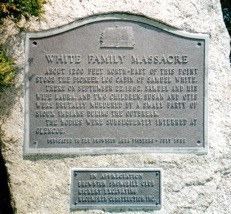

In 1862, Samuel and Laura White and their children, Susan and Otis, were living on Lake Addie in Sumter Township, McLeod County. The Dakota Indians who lived on a reservation some miles south of them were frustrated with their situation for a number of reasons. On August 18, 1862, they went to war with the whites, killing hundreds. On September 22, 1862, a small Dakota raiding party attacked the Whites at their home, killing all four of them. Soldiers retrieved three bodies for burial on September 25, but they could not find Susan. Her body was found later, some distance from the family home. The family shares one gravestone, with Samuel and Laura noted on one side and Susan and Otis on the opposite side. The inscriptions read "Samuel & Laura White, Killed by Indians at Lake Adda, Sept. 22, 1862, Aged 52 & 45 Yr's." and "Susan M. & Otis O. White, Killed by Indians at Lake Adda, Sept. 22, 1862, Aged 14 & 12 Yr's." This monument to the slain White family serves as a permanent reminder of the innocent men, women, and children on isolated farms and townships who were victims of the uprising. It is located on the north side of McLeod County Road 32, just west of Brownton, immediately east of Minnesota Highway 15, and about 0.25 miles north of the intersection of Minnesota Highway 15 and U.S. Highway 212. It is near the White home where they were killed. Their story is related on page 75 of "Dakota Uprising Victims: Gravestones & Stories," published in 2007 by Curtis Dahlin. Inscription: “About 1200 feet north-east of this point stood the pioneer log cabin of Samuel White. There on September 22, 1862, Samuel and his wife Laura, and two children, Susan and Otis, were brutally murdered by a small party of Sioux Indians during the outbreak. The bodies were subsequently interred at Glencoe. Dedication to the Brownton Area Pioneers - July 1982.”
Eliza Muller State Monument


One of the the true heroines of the Dakota War was Eliza Muller. She was the wife of physician Alfred Muller who was at Fort Ridgely during the August 20th and 22nd attacks. She nursed many of the injured and also closed many eyes. A more detailed biography of Eliza is found on page 85 in Curtis Dahlin's book, "The Dakota Uprising, A Pictorial History.” It was her request to be buried in the Fort Ridgely Cemetery. This marker was erected by the State of Minnesota in memory of her valor in 1877. Inscription below on Eliza Muller tombstone: "The State of Minnesota to the Memory of Mrs. Eliza Muller, 1877. Her valor and her devotion to the care of the sick and wounded soldiers and refugees during and after the Sioux Indian Outbreak of 1862 will forever be cherished in the hearts of a grateful people." “Mrs. Eliza Muller, wife of Dr. Alfred Muller, born in Berne, Switzerland, April 21, 1831, died Sept. 26, 1876.”
Broberg-Lundborg State Monument

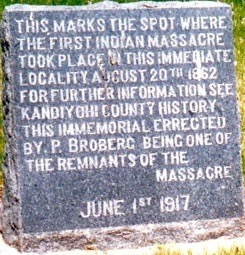
This monument is located on State Highway 8 in the Lebanon Swedish Cemetery in New London. It marks the mass grave of 13 members of the Broberg and Lundborg families who were killed on August 20, 1862 during the Sioux Uprising. The State of Minnesota established the monument in 1891. Here is the inscription: [North side] “This Monument is erected by the State of Minnesota in memory of Anders Petter Lundborg born Mar. 23, 1837. Gustof Lundborg, born Apr. 30, 1839. Lars Lundborg, born Dec. 22, 1840. Anders Petter Broberg, born Sep. 16, 1819. His wife Christina, born Aug. 31, 1826. Their son Johannes, born Jan. 23, 1849. Their son Andreas, born Jan. 27, 1852. Their daughter Christina, born May 31, 1855. Their relative Johannes Nilson. Daniel Petter Broberg, born Jan. 8, 1824. His wife Annastina, born Mar. 31, 1832. Their son Alfred, born Mar. 31, 1858. Their son Johon Albert, born Oct. 22, 1861. [West side] “Anders and Lars Lundborg left Vargorda, Westergotland, Sweden, May 8, 1858, landing at Boston, Mass., June 4, 1858, arrived at West Lake, Minn., in the spring of 1860. Anders Petter Broberg and his brother, Daniel Petter Broberg, with their families left Vargorda, Westergotland, Sweden, Apr. 28, 1861; landed at Quebec, Canada, June 19, 1861, and arrived at West Lake Minn., July 15, 1861. All of these persons were massacred by the Sioux Indians Aug. 20, 1862, while on their way home from a religious meeting held at the house of Andrias Lundborg, in T. 121, R. 36, Kandiyohi Co., and conducted by Rev. Andrew Jackson, all being members of the Swedish Lutheran church. The names of the parties massacred being kept on file in the records of the Nest Lake Lutheran Church of New London, Kandiyohi Co., Minn.” [South side] “This monument was erected August 20,1891, by a special act of the Legislature of Minn. in 1891. John Lundborg, John Peterson and Erick Paulson, were appointed by the Governor, a committee to select and erect this memorial.” [East side] “The massacre of these persons was the commencement of the Indian War of 1862. Derfor varen ock I redo; ty den stund I icke 'menen kommer Menniskosonen, Luc. 12:40.The remains of the massacred were removed from West Lake, Minn., June 19, 1891, and now rest where this memorial is erected. Approved by 1891 legislature; dedicated August 20, 1891.”
Guri Endresen-Rosseland State Monument

Another true uprising heroine, this monument honors Guri Endresen and is located in the Vikor Lutheran Church Cemetery north of Willmar. The State of Minnesota erected the stone in 1907. Her story is told on an accompanying plaque dedicated in 1962: “Guri Endresen-Rosseland Vikor Lutheran Church Solomon Lake. This monument has been placed to honor Guri Endresen-Rosseland and other early settlers of the Solomon Lake Community. The settlers were predominately immigrants from Hardanger, Norway. Among the special characteristics of these were their courage and faith in Almighty God. No one of them exemplified these characteristics more than Guri Endresen-Rosseland whose heroic deeds have resulted in her being acclaimed one of the most outstanding heroines of the nation. The State of Minnesota has recognized her heroism by erecting a monument alongside her grave. This monument is located in this cemetery. During the Sioux Indian uprising of 1862, a band of Indians attacked the Endresen cabin, killing the husband Lars, and a son, Endre. Guri escaped with her infant daughter, Anna, by hiding in the cellar. After the Indians left, she hitched the family oxen to a cart seeking help from her daughter and son-in-law, Gertrude and Oscar Erickson. A day or two later, she headed for Forest City, some thirty miles away. Enroute she stopped at the homes of other settlers, attending to the needs of those wounded in the massacre. Some she took with her. All travel was in darkness. Following the submission of Chief Little Crow and his warriors, Guri returned to the family homestead to rebuild her home. The cabin and graves are preserved in the Guri Endresen cabin site, located two miles west of the church at the end of the marked trail. The Vikor Lutheran Congregation was organized at the Endresen cabin in 1871. It was named after the Vikor Church in Norway which was built by Lars Endresen.” The inscription of her tombstone reads: “Guri Endresen, 1813-1881 Erected by the State in Memory of her Heroic Deeds During Indian Massacre 1862.” For her story, see http://home.online.no/~torolav/guri.html
Almena (Alomina) and Phineas Hurd
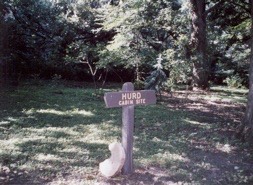
The Hurds and their two children, William and Charley, were living on the northeast side of Lake Shetek in Murray County when the outbreak began. Phineas had gone to the Dakota Territory several months earlier so the farm work was being done by farmhand John Voigt. On August 20, the Dakota attacked the settlement and killed Voigt. Almina recognized her husband’s horse being ridden by one of the attackers. She and her two sons escaped and and after a perilous journey were finally rescued by soldiers after wandering for a week with very little food. Almina moved with her children to LaCrosse, WI, then New York where she met her second husband, Elbridge Woodward, and they became the parents of 11 children. She lived out the remaining years of her life in Pennsylvania where she died in 1922 at the age of 86. Her findagrave memorial was done by Bill Cox. It includes her obituary and is found at this url: http://www.findagrave.com/cgi-bin/fg.cgi?page=gr&GSln=woodward&GSfn=almena&GSbyrel=all&GSdyrel=all&GSob=n&GRid=63748588&df=all&The photo shows the site of the Hurd cabin in Murray County and is courtesy of Bill Cox.